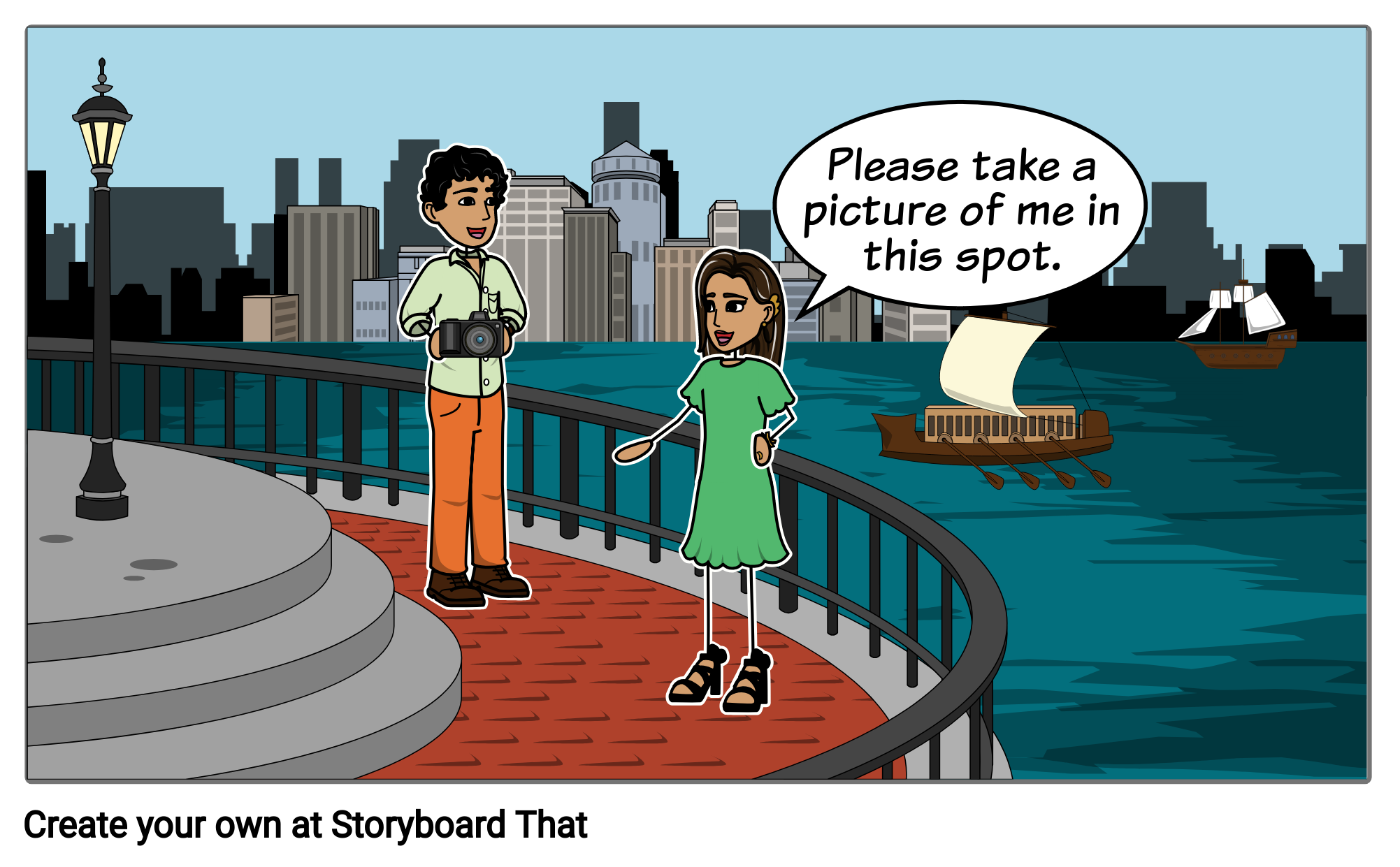LESSON GOAL
Let’s check our lesson goal.
In this material, you will learn English expressions that can be used when sightseeing and practice them.
In this material, you will learn English expressions that can be used when sightseeing and practice them.
このレッスンのゴールを確認しましょう。
この教材では、観光するときに使う英語を練習をします。
この教材では、観光するときに使う英語を練習をします。
PART A_1
Please study the picture below. Then, I will ask you some questions.
PART A_2

| 1. | What are they doing? |
| Answer: | |
| 2. | Who will take the woman’s picture? |
| Answer: |
PART A_3
Now, let us review your answers.
(Please review your student’s answers by sending the correct answers in complete sentences. After that, ask your student to read aloud his or her corrected answers.)
PART B_1
Now, let us read aloud the following sentences. Please repeat after me.
PART B_2
| 1. | What places do you recommend? |
| 2. | I recommend ~ |
| 3. | How much is the admission fee? |
| 4. | The admission fee is ~ |
| 5. | Could you take a photo of me? |
| 6. | Sure, no problem! |
PART C_1
Let us read the dialogue. I will play David and you will play Emma. After reading it once, we’ll switch roles.
PART C_2
| David: | Good morning, Emma. How’s your first day here in the Philippines? | |
| Emma: | Good morning, David. It’s okay. I want to go sightseeing today. What places do you recommend? | |
| David: | I recommend visiting Manila Bay and Rizal Park. The best time to visit these places is in the afternoon so that you can watch the sunset. I can tour you around if you want. | |
| Emma: | Really? That’s very nice of you. By the way, your friend told me that there’s an art gallery nearby. How much is the admission fee? | |
| David: | The admission fee is one dollar. However, the art gallery is closed today, but you can visit it tomorrow. It will be open from 10 a.m. to 4 p.m. | |
| Emma: | Okay. Could you take photos of me while we tour around? I’d like to show it to my parents. They’re in Japan. | |
| David: | Sure, no problem! By the way, we have to ride a jeepney to go to Manila. It’s our country’s common means of transportation. | |
| Emma: | Okay. I’ve seen jeepneys on my way here yesterday and I can’t wait to ride one. |
PART D_1
Please answer the questions based on the dialogue.
PART D_2
| 1. | What are the two places that David recommends Emma to visit? |
| Answer: | |
| 2. | How much is the art gallery’s admission fee? |
| Answer: |
PART D_3
Now, let us review your answers.
(Please review your student’s answers by sending the correct answers in complete sentences. After that, ask your student to read aloud his or her corrected answers.)
PART E_1
Let us complete following sentences. Choose the correct answers from the box below.
PART E_2
| visit | admission fee | recommend | transportation |
| 1. | Train is one of the most common means of __________. |
| 2. | I __________ that you go to Universal Studios Japan in October. |
| 3. | How much is the __________ at the park? |
| 4. | Which place do you want to __________ tomorrow? |
PART E_3
Now, let us review your answers.
(Please review your student’s answers by sending the correct answers in complete sentences. After that, ask your student to read aloud his or her corrected answers.)
PART F_1
Now, I will ask you some questions. Please answer in complete sentences.
PART F_2
| 1. | What are the most famous sightseeing spots in your country? |
| Answer: | |
| 2. | What do you think is the most interesting place in the world? |
| Answer: | |
| 3. | Which do you prefer, sightseeing in your own country or abroad? |
| Answer: |
PART G_1
Now, you will ask me questions. Please ask me questions using the items given.
PART G_2
| 1. | sightseeing spots in the Philippines |
| Tutor’s answer: | |
| 2. | place/s you want to visit |
| Tutor’s answer: |
PART G_3
Now, let us review your answers.
(Please review your student’s answers by sending the correct answers in complete sentences. After that, ask your student to read aloud his or her corrected answers.)
REVIEW AND FEEDBACK
Now, let us review the things that you learned in this lesson.
ではこのレッスンで学んだことを振り返りましょう。
(Please give a short feedback on how your student did on your class.)
| Grammar 文法 |
Pronunciation 発音 | Vocabulary 単語 |
Comprehension 理解 |
|
|---|---|---|---|---|
 GOOD GOOD |
文法の誤りはほとんどなく、完全な文章で話すことができる | ほとんどの単語をはっきりと正しく発音することができる | 習った表現を適切に使うことができる | 文章を理解し、質問に正しく答えることができる |
 FAIR |
文法の誤りはあるが、完全な文章で話すことができる | 発音の練習が必要な言葉がいくつかある | たまにミスはあるが、習った表現を適切に使うことができる | 文章を完全に理解するのは難しく、質問に正しく答えられないときもある |
 POOR |
文章で話すのは難しく、単語だけで話すことができる | 発音の練習が必要である | 習った単語と表現を少しだけ使うことができる | 文章を理解するのは難しく、質問に答えるのは難しい |
レッスン教材に関するアンケートのお願い
レッスン教材の改善・拡充を図ることを目的とし、アンケートを実施しております。
以下のURLからアンケートにお答えいただき、 ご意見・ご要望をお聞かせください。
アンケートはこちら